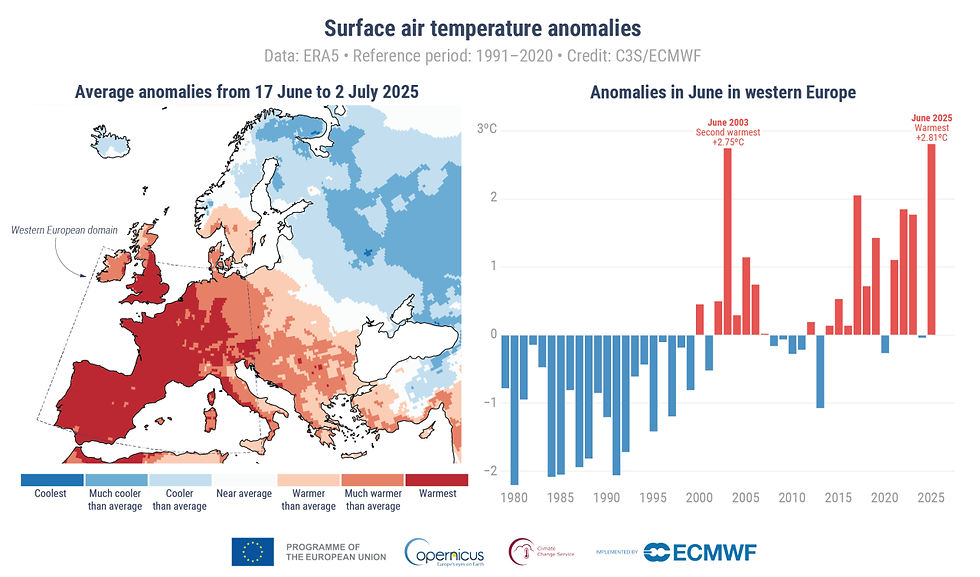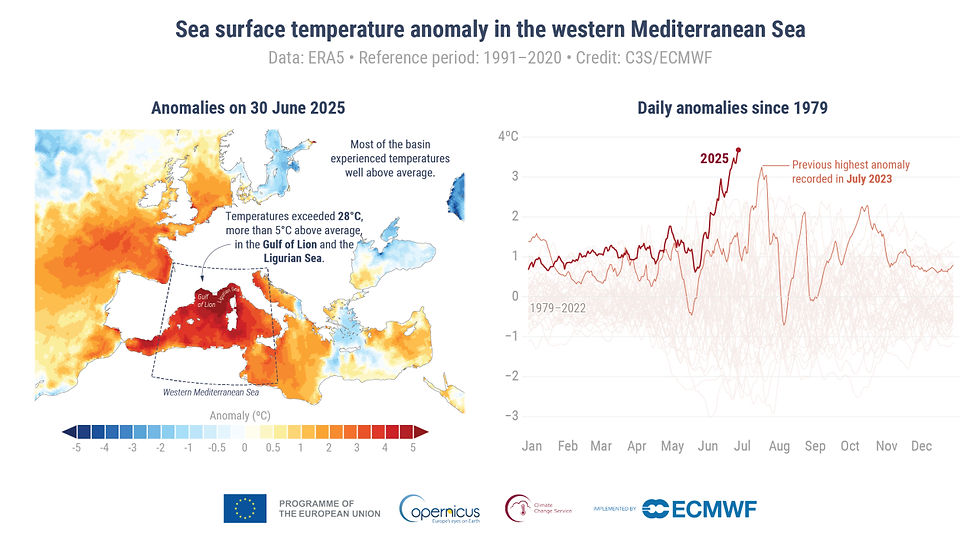Copernicus Climate Bulletin warns Europe & the Mediterranean on temperature anomalies.
- M Abti
- Aug 22
- 4 min read
June was a month of record for the temperatures reached in the Mediterranean area. This is not an alarmist spot but the result from precise studies. The Climate Bulletin leaves no doubt of interpretation. And we are talking about a reliable periodic report elaborated by the Copernicus Climate Change Service (C3S) on the state of Planet Earth's climate using key climate change indicators. As a result of the strong heat waves which affected much of the European continent, up to + 20.49°C (surpassing +0.06°C registered in June. 2003), with a feels-like temperatures reaching 46°C in Spain and in Portugal. Meanwhile, the temperatures in the Western Mediterranean Sea reached worrying peaks, reinforcing the effect of heat determined by high pressure of African origin.
The combination of two heat waves, created great stress on European and Mediterranean ecosystems, also determining a strong social impact on human communities. The European State of the Climate by the EU C3S and the World Meteorological Organisation - WMO - highlighted how the most densely populated areas are more at risk due to the urban heat island (UHI) effect, which detects city areas clearly much warmer than the surrounding rural territories. The large presence of paved surface, the concentration of buildings and the heat emitted by vehicles and other sources, combined with air pollution concentrations (PM10 and PM2.5), can increase mortality during hot periods.
Not by chance, the Intergovernmental Panel on Climate Change Sixth Assessment Report highlights that most European populations may be affected by high or very high risk of heat stress during summers, by 2050. A dangerous trend recently confirmed by Samantha Burgess, Strategic Lead for Climate at European Centre for Medium-Range Weather Forecasts - ECMWF - a key intergovernmental organisation supported by 20 European Member States and 14 Cooperative States.

Thermal anomalies naturally do not only concern the European continent and do not necessarily only concern heat. While June 2025 was classified as the fifth warmest month comparing to the 1991-2020 average, heat waves had a wider and global diffusion including United States, Northern Canada and Central Asia (e.g.: Japan, partly China and Korea). In the other hemisphere in reverse, South America is being experiencing an unusually cold winter, influenced by freezing currents from the Antarctica.

With reference to the waters of the Mediterranean Sea, their warming reached tropical thresholds in June, up to reach the highest daily Sea Surface Temperature (SST), that was 27.0°C (+3.7°C above average). All that may produce fatal effects for endemic marine biodiversity: the increased frequency and duration of these phenomena can negatively affect fish stocks, as well as seaweeds and seagrasses which act very much like forests on land, ensuring shelter for many species and helping to produce oxygen, while maintaining healthy and nutrient-rich water quality. Heat waves can also induce "sub-lethal effects", that is preventing marine creatures from reproducing: another possible fatal impactful consequence. Last but not least, the anomalous evaporation of marine waters, fueled by excessive heat, can cause torrential rains capable of causing damage to human beings and the environment.
Similar SST anomalies have also been recorded in the western North Atlantic, in the western North Pacific, and from the western equatorial Pacific to the northeast of Australia.

The heat waves and dry climate produce particularly impactful domino effects such as the spread of large-scale fires or floods. The heat waves that hit Europe's Western and Southern regions, Southern Great Britain, the Southern part of Sweden and Western Russia caused wildfires in Portugal and Turkey, while Iceland, Ireland, Northern Great Britain, Denmark, the Baltic Region, the Belarus and parts of Ukraine and Russia were affected by above-average rainfall concentrations.
On a larger scale, Eastern Africa, the Arabian Peninsula, Central Asia, East China, Japan, Australia, Southern Africa, Part of South America, United States and Canada suffered a prolonged dry period. Southern United States, Northern Mexico, Northern and Southwestern Asia, parts of China, Northern Australia and Southern Brazil they witnessed torrential rains. And even the polar regions were not excluded from the anomalies: the in June 2025, the Arctic Sea ice extent was 6% below the 1991-2020 average (the 2nd record lowest extent for the month) while the Antactic Sea was 9% below the 1991-2020 average (the 3rd record lowest extent for the month). ***

✒️ Maurice Abbati
Strategic Communication Specialist, Editor in Chief, Journalist, Executive.
Lecturer and Author in English in the field of Environmental Communication to foster Circular and Blue Economy.































































Comments